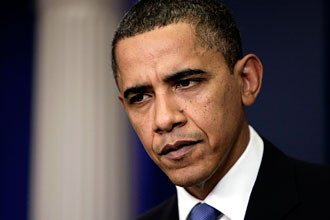Now Playing: India can benefit only if the govt plays the cards well
Topic: INDO-US RELATIONS

“We don’t want to be part of arming you against India, so let me be very clear about that”, US President Barack Obama told Pakistan President Asif Ali Zardari a few days ago just as his plans to visit India on a business trip firmed up. There is much of agonizing heartache which Pakistan can’t hide, so much that the border districts of Jammu and Kashmir have been getting an artillery pounding from across the Line of Control.
But then, the biggest fear that Pakistan has is that the business emphasis of the US President’s visit can relegate its pet peeve Kashmir to the back-burner as India and the US warms up to better relations like no other President did in the past. President Barack Obama is slated to be in India for three days, which is by far his longest visit to any country yet.
Though there has been trouble on the outsourcing front as pointed out by this magazine a few weeks ago, the market size of India is the biggest draw for any US President. Coupled with that is the fact that the US will always look to India as a countervailing force to hegemony of China in the region.

The benefits for the US in dealing with India and its burgeoning market is that it can hugely affect US corporates, especially in the FMCG and retail sector. Wal-Mart CEO Mike Duke has repeatedly said that the direct effect of allowing FDI in organised retail will be in controlling inflation. Prices of agricultural commodities will plummet if organised retail sector gets the FDI fillip in expanding to rural unexplored areas, just as the farmers would get better realization on their produce.
President Obama is coming along with a high-powered business delegation which includes CEOs of many Fortune 500 companies. The delegation’s main agenda would be about outsourcing of information technology services, entity list, science and technology agreements, social security tax and aviation. The discussions will take place with Indian counterparts on November 6.
It is to be noted that Obama’s predecessors George Bush and Bill Clinton also addressed Indian industry leaders when they visited India during their tenure. The visit of President George Bush, whom Prime Minister Manmohan Singh once addressed as India’s best friend, had a better rapport with the Indians than Bill Clinton, though the picture of Clinton dancing with the tribals in Rajasthan is etched in the minds of Indians like none else.
Even if the agenda of the US President is quite a secret, news reports suggest that the US-India Business Council (USIBC) will jointly host a day-long seminar with the Confederation of Indian Industry (CII) and Federation of Indian Chambers of Commerce & Industry (FICCI).

It is also known that Terry McGraw, USIBC chairman would lead the US delegation. Just as in previous US President’s visit to India US secretary of commerce Garry Locke, treasury secretary Tim Geithner, and agriculture secretary Tom Vilsack are expected to be accompanying the delegation.
There is also speculation over `entity list’ which will figure in the talks between the US President’s delegation and their Indian counterparts. The entity list contains names of companies and individuals dealing in `sensitive’ areas.
The US Export Administration Regulations (EAR) put out by the US Bureau of Industry & Security (Department of Commerce) contain a list of names of certain foreign persons that are subject to specific licence requirements for the export, re-export and transfer of specified items. The list includes businesses, research institutions, government and private organisations, individuals, and other types of legal persons. It is this list which India would like to see altered.
Another area of contention is aviation. The penalty for late delivery of commercial aircraft to India could also figure in the talks. For many Indians visiting US on short term visa there is this crying need to alter the social security tax paid.
India is quite clear on what it wants on this issue – businessmen paying tax in India should be exempted from social security tax in the US when they are on a short-term visa. It is estimated that if India gets this leeway there could be an annual saving of $1.5-billion.
Beyond business, India is seriously concerned with the delay in full implementation of Indo-US civilian nuclear agreement. After the hype over the deal which was much to the chagrin of Pakistan, Obama Administration has been squarely blamed by Indian government for the delay.
But more than seen in the public eye about business and trade which can keep the constituencies in the US as well as India happy for US President Barack Obama and Indian Prime Minister Dr Manmohan Singh, the tenor of dialogue on various terror related issues would decide how life will be different in the near term for both countries.
Pakistan’s complicity in terror attacks in India is beyond doubt and the US President’s statements have increasingly been over the edge, almost as if there is an attempt to control his fury. And the US has every reason to be furious at the double game played in India’s neighbourhood in the name of freedom and azadi.
******************
